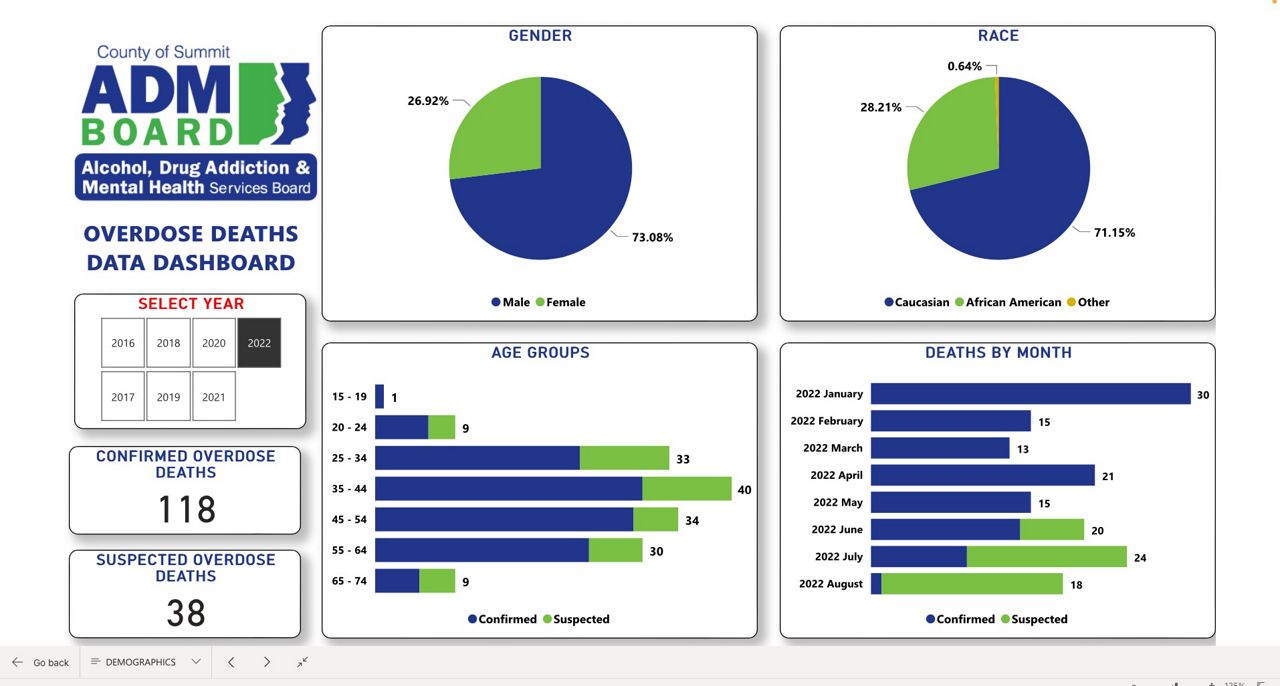SUMMIT COUNTY, Ohio — Despite multiple agencies working to reduce drug abuse, opiate overdose deaths are on track to number the same as, or more than, last year, said Medical Examiner Dr. Lisa Kohler.
Since 2020, the number of opiate-related deaths has risen 70%, Kohler said during an online Overdose Awareness Day press conference hosted by Summit County Executive Ilene Shapiro’s office. Kohler was a member of a panel of local leaders and professionals from agencies related to drug addiction, treatment and recovery.
What is alarming in Summit County, Kohler said, is an 18% increase in overdose deaths among African American women. There were 11 deaths in 2020, 13 in 2021 and with nine deaths so far this year, the county could exceed past years.
The makeup of drugs on the street is changing, she said. Heroin and fentanyl were prevalent prior to 2016, but since then, fentanyl has become more powerful and mixed with other drugs.
“So it's much stronger than it was and it's always been stronger than heroin would be,” she said. “When we're looking at the individual types of drugs such as fentanyl, most people don't really know what it is they're purchasing. They all look very similar. It's a white powder.”
Historically, death by opiate overdose has not been as pervasive in the African-American community as other communities, so conversations about these drugs need to start happening, said Aimee Wade, Executive Director of the county’s Drug Addiction & Mental Health Services Board (ADM Board).
“But it's critical that we reduce the stigma, get people into treatment and understand what's out on the streets and the implications for the use of different substances,” she said.
The ADM Board operates an Opiate Addiction Task Force in partnership with Kohler’s office.
The agency allocates more than $12 million to 16 provider agencies and programs working in addiction prevention, treatment and recovery across Summit County, Wade said.
The ADM Board addiction-help hotline is open 24/7 and can be reached by calling 330-940-1133. Callers are connected with treatment and services via conversations with people, she said.
The pandemic created a perfect storm for drug abuse, said Summit County Health Commissioner Donna Skoda, because when the world shut down, people lost support groups and other personal connections.
“AA groups didn't meet, churches were closed and a lot of things changed quickly, and didn't change for the better for a group of folks who really needed the supports,” she said.
The health department, like many Summit County agencies, are focused on harm reduction strategies, she said.
“We need to get folks into treatment, but they have to live long enough to get to treatment,” Skoda said.
Skoda and other panel members talked about the importance of reducing the stigma around addiction, which could prompt more people to get treatment.
“You know, addiction is a disease, it is not a weakness,” she said. “It's certainly not character. It's your brain. It's chemistry.”
When crack hit in the African-American community, it was considered a personal problem, not a public health crisis, so people didn‘t get the help they needed, said The Remedy Church Pastor Deante Lavender.
Now, people are less inclined to ask for help with opiate addiction, even though agencies tell them, “it’s okay to ask for help,” he said.
“I think that model or that mantra is very much understood from the people who're giving the help, but not the people who actually need the help,” he said.
People aren’t aware how deadly street drugs have become and with heightened stress from the pandemic and the escalating cost of living, they’re looking for stronger drugs to escape, he said. It’s the agencies’ job to communicate the help that’s available.
“They won't ask, but they will show up if we offer programs,” Lavender said.

The city has equipped all its first responders with naloxone, which has been critical in saving lives, said Mayor Dan Horrigan.
Summit County’s Quick Response Teams, each composed of a medic, a police officer and a public-health professional, have paid about 300 visits to addresses where people have overdosed, he said.
“We're there knocking on your door on Thursdays, and maybe we can expand, and maybe we can do some different things,” he said.
Mark Salchak, a certified recovery coach at IBH Addiction Recovery, said he will mark the first anniversary of his son’s overdose death on Friday. Salchak created the REACH project in 2014, which stands for recovery, education, accountability, community and hope, he said.
REACH now has 1,200 members who have put in thousands of hours of community service and hosted more than 2,000 support meetings, he said. The group now has an 84% clean and sober rate.
Salchak compared addiction to a pizza — one slice is the amount of time a person might spend in treatment, he said. The rest is the environment outside that treatment, which is the process of change that leads to wellness.
“Treatment is discovery,” he said. “And recovery comes after the discovery.
Summit County was awarded $104 million in 2019 in a civil suit against pharmaceutical companies and opioid distributers for opiate addiction and recovery services.
Funds distributed to date include $7 million for addiction-related programs and $2.5 million in emergency department services for overdose patients, said Summit County Communications Director Greta Johnson, who moderated the panel discussion. More than $2. million supports a program for mothers and babies through their first year, while $1 million went to Akron Community Foundation to fund grass-roots, drug-related initiatives, she said.
“I want to encourage people to encourage their family, their friends, if they are in that deep stage of addiction, that they need immediate help, that they can go to an emergency room and they will be treated with dignity and respect,” Johnson said.
People looking for addiction support can go to the health department website for information on the Safe Summit Syringe needle exchange or to obtain naloxone or fentanyl test strips to help people stay safer, Skoda said.
To view the panel discussion in its entirety, visit the Summit County Executive’s Facebook page.



